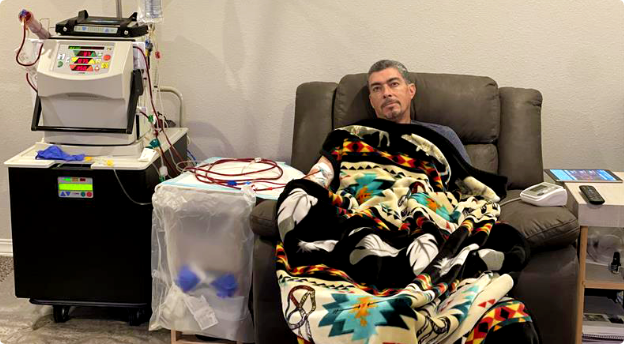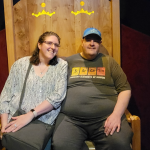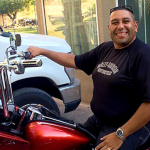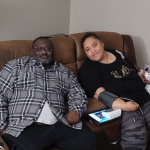How It Is, How It Was, and How Joe Made It Through
“It all started with my mom,” Joe remembers. “She was very sick, so we took her to the ER. The doctors told us her kidneys were bad and that she needed a kidney or dialysis. I said ‘What do you mean she needs a kidney? And what’s dialysis?’”
Once his mother’s situation had been explained, Joe immediately wanted to donate a kidney. He soon learned that wouldn’t be possible because he had the same illness as his mom – polycystic kidney disease (PKD). PKD is a hereditary disorder that causes cysts in the kidneys and typically leads to end stage kidney disease (ESKD).
Joe’s mom was on dialysis for six years and eventually got a transplant, but two months later she passed away due to complications. Throughout that time, Joe learned all he could about ESKD and dialysis, while keeping an eye on his glomerular filtration rate (GFR). In April of 2021, with his kidney function at 28%, he had a fistula implanted. If the time came when he needed dialysis, he wanted to be ready. But there was no way Joe could have prepared himself for what was coming.
It was Christmas time 2021, and Joe, his daughter, and his father-in-law all felt sick. As it turned out, they had COVID-19. A few days after Christmas, Joe went to the hospital because he couldn’t breathe.
“That’s when my nightmare started,” says Joe. “They put me in a wheelchair and isolated me. Then three doctors came in and asked me three questions: ‘if you need a blood transfusion are you ok with that?’, I said yes, ‘if we have to resuscitate you are you ok with that?’, I said yes, and ‘if we need to intubate you are you ok with that?’, and I said no. All three doctors looked at my wife and she told them ‘he is very conscious to still make his own decisions.’”
A week later, Joe felt better but his health was getting worse. COVID had attacked his lungs and kidneys, his GFR was at 6%, and without intervention he would have died. In January 2022, he and his wife Rose had to decide whether to intubate him. Even with intubation, he was only given a 10% to 20% chance of surviving. They chose to keep fighting.
“I went to sleep (under anesthesia) and when I woke up, I thought it was the next day,” Joe remembers. “But it was 30 days later.”
Though he’d survived, Joe’s ordeal was far from over. While his own life had been spared, he learned that his father-in-law lost his own COVID-19 battle. And he still had a long way to go. He spent another two months in hospitals and rehabilitation facilities, was on a feeding tube, and received continuous renal replacement therapy, a 24-hour-a-day form of dialysis. He faced the possibility of death several more times due to complications with his feeding tube and other mishaps.
By the time Joe was allowed to go home, it was mid-March 2022. He’d lost 65 pounds, was on oxygen, and getting around in a wheelchair. But Rose forced him to start moving and within a month he was using a walker. They found him a chair at a local dialysis center, and he began in-center hemodialysis (ICHD). And while Joe’s overall health improved, ICHD didn’t agree with him. He regularly suffered with cramps, nausea, vomiting, and fatigue.
“He wasn’t himself, because he was still recovering,” Rose remembers. “But on top of that, he kept having to regain his strength. Every time he would go to the center it was like we were losing three days of progress. He had no energy for anything and just wasn’t feeling good at all.”
About eight months after starting ICHD, Joe’s social worker and nephrologist began talking to him about more frequent home hemodialysis (HHD) with a NxStage system. He had never heard about this therapy option, but Joe and Rose discussed it and decided to give it a try. He started out getting more frequent therapy (five days a week) at the center, to see how he’d feel. It was literally just what the doctor ordered.

“I saw a difference right away,” says Rose. “By the second day he was more energized. He would walk out of the center with the same energy as he had walking in. There was no nausea, no fatigue. He could even drive the car home.”
The couple started training at the end of the first week and it was only a few more weeks until they were ready to do therapy at home. Joe says the training nurses were fantastic from day one.
“I saw a difference right away,” says Rose. “By the second day he was more energized. He would walk out of the center with the same energy as he had walking in. There was no nausea, no fatigue. He could even drive the car home.”
“They were so patient with us,” he recalls. “The first week they showed us how, the second week was more hands on, and by the end of the third week they said, ‘Now that we’ve worked with you and your wife, we know you’re going to be a great team.’”
Once home, Joe admits there were some bumps in the road, but that NxStage Technical Support and his care team have been helpful and encouraging every step of the way. He and Rose are now well-practiced, and he says, “things are really smooth now.” And the best change that came with HHD is that Joe is feeling like his old self again.
“I finish therapy and I’m energetic,” he says excitedly. “My friends and family don’t believe I’m on dialysis. I have to show them the band-aids!”
“It’s like a new job,” he explains. “You need to learn the ins and outs, but the difference is, with this “job” you have the potential to feel better.”
Joe says he now goes to the gym three days a week, and takes two daily walks, for which he includes his children, grandkids, and dogs whenever possible. He and Rose also started dancing at a Mexican night club every two weeks, something he never imagined doing when he was in-center. Often times evenings consist of watching movies with the family.
“We turn therapy time into family time,” he says.
For anyone who struggles with ICHD like Joe did, he recommends looking into more frequent HHD – for the potential health benefits and the ability to schedule your own therapy times.
“It’s like a new job,” he explains. “You need to learn the ins and outs, but the difference is, with this “job” you have the potential to feel better.”
With all they have been through, Joe says he and his family have a new outlook. They don’t worry about the little things and focus on spending time together and being there for one another.
“After COVID hit our family, we started saying ‘Everything is fixable except death,’” he says with confidence. “If something gets broken, we can always fix or replace it. But we are human beings, and we are not replaceable.”
Joe is a NxStage Patient Advocate
Home hemodialysis with NxStage systems involves risks, and you may not experience the potential benefits of such therapy. NxStage systems require a prescription for use. If your doctor prescribes more frequent therapy, your vascular access is exposed to more frequent use which may lead to access related complications, including infection of the site.





